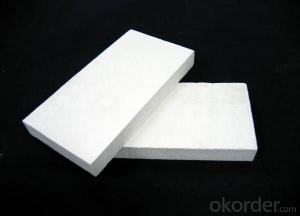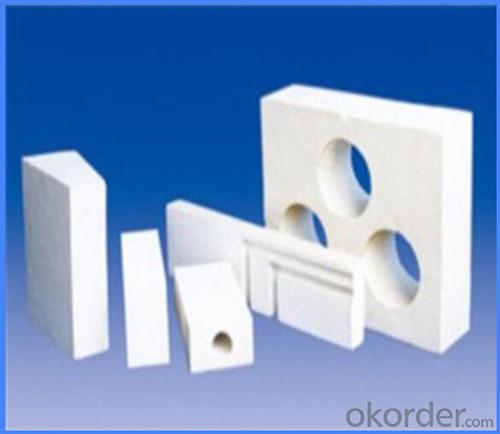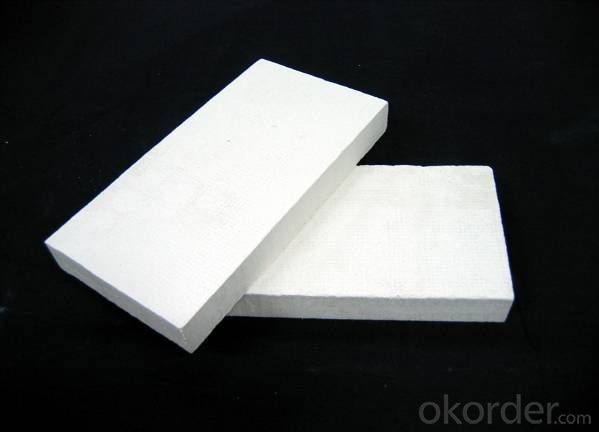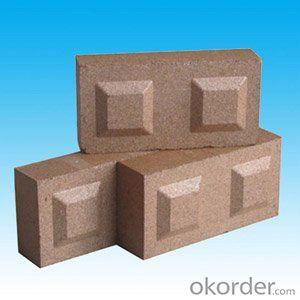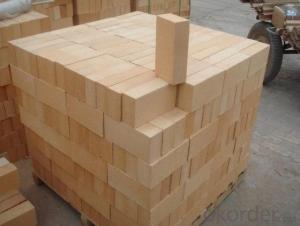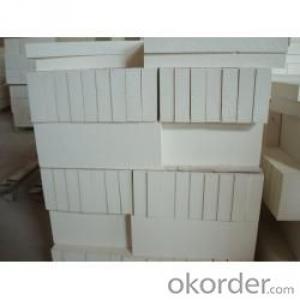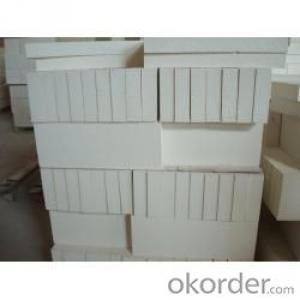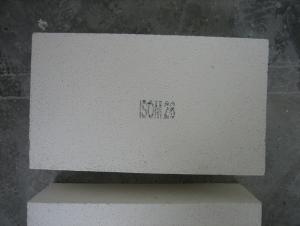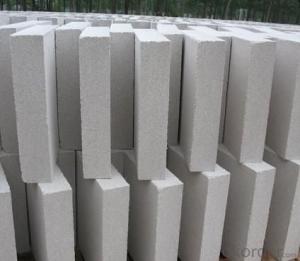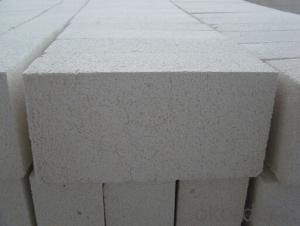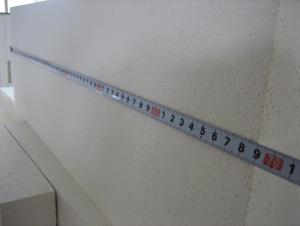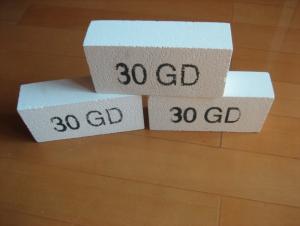Insulating Fire Brick - Refractory JM Mullite Insulation Brick JM-26
- Loading Port:
- Shanghai
- Payment Terms:
- TT OR LC
- Min Order Qty:
- 10 m.t.
- Supply Capability:
- 1000 m.t./month
OKorder Service Pledge
OKorder Financial Service
You Might Also Like
Refractory mullite insulating refractory brick JM 23
Okorder series heat insulation brick
Okorder series thermal insulation brick is an effective, energy saving, low carbon, environmental protection advanced, according to the ASTM standard manufacturing products. Okorder series products are best Li Ning and insulation in all types of industrial furnaces in the metallurgical field, aluminum, petrochemical, electric power and glass ceramic materials. They can be used as part of the working layer of thermal insulation or non - melting. Products have been widely used in the following furnace, achieved satisfactory results.
Application of heat preservation brick
Metallurgical Industry: blast furnace, hot blast furnace, heating furnace, etc..
Petrochemical Industry: ethylene cracking furnace, hydrogen production furnace, primary reformer, heating furnace, etc..
Ceramic industry: roller kiln, kiln, etc..
Glass industry: glass furnace regenerator, etc.
Carbon industry: carbon furnace, etc..
Aluminum electrolysis industry: aluminum reduction cell, etc.
Other industries: tunnel kiln, shuttle kiln, etc..
Advantages of heat insulation brick
Low thermal conductivity: more porosity will bring good thermal insulation effect, energy saving.
High crushing strength: high crushing strength, volume stability.
Low heat storage: small heat storage to absorb more heat, energy-saving effect is obvious.
Gao Chundu: iron, alkali metal impurity content is low.
The precise size: Brick size processing precision, special shape cutting and grinding, accelerate the brickwork.
Insulating brick picture
Common problem solutions
1. What products do you have?
We have all kinds of refractory bricks, refractory casting materials, mortar, cement, ceramic fiber products, etc..
Or you can browse our products to choose what you need.
2. How to control product quality?
With strict quality control system throughout the material selection and production process, we have the quality of refractory materials and ceramic fiber products to meet customer requirements.
From the selection of raw materials, the quality of our control to start. The quality certificate of the raw material is required, each batch of the products are to be tested in the use of the forward line. In the production process, the quality control by the workers, and then each piece of classification, and through the quality supervision and inspection.
3. Can you give me a brief introduction to the application of your product?
My company is mainly engaged in refractories in the steel, cement, glass, ceramics, petrochemical, electric power and other industries.
4. What information do you need if I need you?
In order to select the right products, we will provide us with information, such as the United States, technical data, order quantity, product application, etc..
If you have any questions, please contact us.

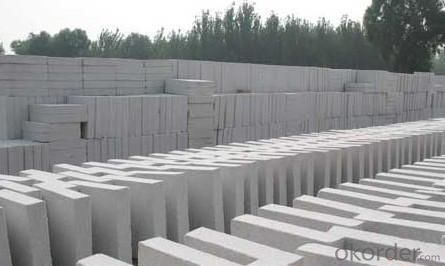


- Q: Can insulating fire bricks be used in the construction of tundishes?
- Insulating fire bricks are indeed applicable for tundish construction. They possess exceptional thermal insulation qualities and are lightweight, which makes them perfect for situations that demand heat retention. Tundishes, utilized in the steel industry to regulate molten metal flow, necessitate materials capable of enduring high temperatures while minimizing heat loss. Insulating fire bricks excel in this area, successfully enduring extreme temperatures within tundishes, thereby safeguarding the desired molten metal temperature and preventing heat loss. Moreover, their lightweight nature facilitates uncomplicated handling and installation during tundish construction. In conclusion, insulating fire bricks prove to be a suitable choice for tundish construction due to their thermal insulation qualities and ability to withstand high temperatures.
- Q: Are insulating fire bricks resistant to hydrofluoric acid?
- Insulating fire bricks are not resistant to hydrofluoric acid. Hydrofluoric acid is a highly corrosive substance that can attack and dissolve many materials, including fire bricks. It is important to handle hydrofluoric acid with extreme caution and use appropriate protective equipment when working with this hazardous substance.
- Q: Are insulating fire bricks eco-friendly?
- To some extent, insulating fire bricks can be considered environmentally friendly. These bricks are typically crafted from abundant natural materials like clay, shale, and other fire-resistant minerals. The manufacturing process involves firing the bricks at high temperatures, which can consume a lot of energy. However, advancements in manufacturing techniques have mitigated the environmental impact by using more efficient kilns and recycled materials. Furthermore, insulating fire bricks boast a long lifespan and can endure high temperatures. This means they require less frequent replacement compared to other brick types, resulting in reduced waste generation and resource consumption over time. Moreover, these bricks possess exceptional thermal insulation properties, which can contribute to decreased energy consumption in various applications. By minimizing heat loss, insulating fire bricks can enhance energy efficiency and reduce carbon emissions in both buildings and industrial processes. Nevertheless, it is crucial to note that the eco-friendliness of insulating fire bricks also hinges on their proper disposal at the end of their life cycle. If not recycled or disposed of appropriately, they can contribute to landfill waste and potential environmental pollution. In conclusion, while insulating fire bricks offer certain environmentally friendly features, such as being made from natural materials and their energy-saving properties, their overall environmental impact also depends on responsible manufacturing, usage, and disposal practices.
- Q: Do insulating fire bricks have a high heat storage capacity?
- Yes, insulating fire bricks do have a high heat storage capacity. These bricks are designed to retain heat for extended periods of time, making them ideal for applications that require heat insulation and retention, such as furnaces, kilns, and fireplaces.
- Q: Are insulating fire bricks resistant to oil and gas?
- Insulating fire bricks are generally resistant to oil and gas. These bricks are made from high temperature materials such as alumina and silica, which provide excellent thermal insulation properties and can withstand high temperatures. They are commonly used in industries where there is exposure to heat, such as in furnaces, kilns, and fireplaces. However, it is important to note that the resistance to oil and gas can vary depending on the specific composition and manufacturing process of the insulating fire bricks. Some bricks may have a higher resistance to oil and gas compared to others. To ensure the best resistance to oil and gas, it is recommended to use insulating fire bricks that are specifically designed for such applications. These bricks are often referred to as oil and gas resistant fire bricks and are manufactured with additional additives or coatings that enhance their resistance to these substances. In summary, while insulating fire bricks are generally resistant to oil and gas, it is advisable to use bricks that are specifically designed for such applications to ensure optimal performance and longevity.
- Q: How do insulating fire bricks affect the overall carbon footprint of a structure?
- Insulating fire bricks can significantly reduce the carbon footprint of a structure. These bricks have higher thermal insulation properties compared to traditional bricks, which means they can better retain heat and reduce the need for excessive heating or cooling. By improving energy efficiency and reducing the consumption of fossil fuels, insulating fire bricks help to lower the carbon emissions associated with the structure's operation. Additionally, their longer lifespan and recyclability contribute to further environmental benefits by reducing waste generation and the need for frequent replacements, ultimately minimizing the overall carbon footprint of the structure.
- Q: Are insulating fire bricks suitable for insulation in walls?
- Insulating fire bricks are not typically suitable for insulation in walls. While they are excellent for high-temperature applications, such as lining furnaces or kilns, they have limited insulation properties when it comes to walls. Insulating fire bricks have lower thermal conductivity than regular bricks, meaning they conduct heat at a slower rate. However, they are not as effective as other insulation materials specifically designed for walls, such as fiberglass, foam boards, or mineral wool. These materials are specifically engineered to provide superior insulation properties, such as higher R-values, which measure the material's resistance to heat transfer. Additionally, insulating fire bricks are often more expensive and heavier than other insulation options, making them less practical for wall insulation. Therefore, while insulating fire bricks have their advantages in certain applications, they are generally not the best choice for insulating walls.
- Q: Can insulating fire bricks be used in aluminum smelting furnaces?
- Yes, insulating fire bricks can be used in aluminum smelting furnaces. These bricks have high insulating properties and can withstand the high temperatures required for aluminum smelting. They help to maintain the heat within the furnace, improve energy efficiency, and reduce heat loss, making them suitable for use in such furnaces.
- Q: Does the building with the exterior wall thermal insulation brick require adding an angle steel bracket in the middle of the brick?
- There is no mandatory requirement, but the thermal insulation system should use expansion bolts to do the pullout test, and the exterior wall tiles also need pullout tests.
- Q: Are insulating fire bricks suitable for insulation in cryogenic applications?
- Insulating fire bricks are indeed appropriate for insulation in cryogenic applications. These bricks are crafted from lightweight refractory materials that possess exceptional thermal insulation qualities. With their low thermal conductivity, high melting points, and ability to withstand extremely frigid temperatures, they are perfectly suited for cryogenic applications. Cryogenic applications entail the handling and storage of materials at exceedingly low temperatures, typically below -150 degrees Celsius (-238 degrees Fahrenheit). Insulating fire bricks are specifically designed to provide efficient insulation in such extreme conditions, effectively preventing heat transfer and maintaining the desired low temperature. Moreover, insulating fire bricks exhibit chemical stability and possess excellent resistance to thermal shock. This means they can endure rapid temperature fluctuations without cracking or deteriorating, which is particularly crucial in cryogenic applications where such variations are commonplace. In addition to their exceptional thermal insulation qualities, insulating fire bricks are lightweight and easy to handle, making them convenient for installation in cryogenic systems. All in all, insulating fire bricks are a suitable choice for insulation in cryogenic applications due to their thermal insulation properties, resistance to high temperatures, chemical stability, and ability to withstand thermal shock.
Send your message to us
Insulating Fire Brick - Refractory JM Mullite Insulation Brick JM-26
- Loading Port:
- Shanghai
- Payment Terms:
- TT OR LC
- Min Order Qty:
- 10 m.t.
- Supply Capability:
- 1000 m.t./month
OKorder Service Pledge
OKorder Financial Service
Similar products
Hot products
Hot Searches
Related keywords



